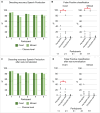Don't put words in my mouth: speech perception can falsely activate a brain-computer interface
- PMID: 40830488
- PMCID: PMC12362870
- DOI: 10.1186/s12984-025-01689-7
Don't put words in my mouth: speech perception can falsely activate a brain-computer interface
Abstract
Background: Recent studies have demonstrated that speech can be decoded from brain activity which in turn can be used for brain-computer interface (BCI)-based communication. It is however also known that the area often used as a signal source for speech decoding BCIs, the sensorimotor cortex (SMC), is also engaged when people perceive speech, thus making speech perception a potential source of false positive activation of the BCI. The current study investigated if and how speech perception may interfere with reliable speech BCI control.
Methods: We recorded high-density electrocorticography (HD-ECoG) data from five subjects while they performed a speech perception and a speech production task. We first evaluated whether speech perception and production activated the SMC. Second, we trained a support-vector machine (SVM) on the speech production data (including rest). To test the occurrence of false positives, this decoder was then tested on speech perception data where every perception segment that was classified as a produced syllable rather than rest was considered a false positive. Finally, we investigated whether perceived speech could be distinguished from produced speech and rest.
Results: Our results show that both the perception and production of speech activate the SMC. In addition, we found that decoders that are highly reliable at detecting self-produced syllables from brain signals may generate false positive BCI activations during the perception of speech and that it is possible to distinguish perceived speech from produced speech and rest, with high accuracy.
Conclusions: We conclude that speech perception can interfere with reliable BCI control, and that efforts to limit the occurrence of false positives during daily-life BCI use should be implemented in BCI design to increase the likelihood of successful adoptation by end users.
Keywords: ALS; Brain-Computer interface; Communication; Locked-in syndrome; Neuroprosthesis; Reliability; Speech decoding.
© 2025. The Author(s).
Conflict of interest statement
Declarations. Ethics approval and consent to participate: The study was conducted in accordance with the Declaration of Helsinki (2013) and approved by the Medical Ethical Committee of the University Medical Center Utrecht. All participants gave written informed consent for participation in this study. Consent for publication: All participants gave written informed consent for publication of their data acquired in this study. Competing interests: MJ Vansteensel is a consultant for GA Capital. The other authors have no relevant financial or non-financial interests to disclose.
Figures




Similar articles
-
Prescription of Controlled Substances: Benefits and Risks.2025 Jul 6. In: StatPearls [Internet]. Treasure Island (FL): StatPearls Publishing; 2025 Jan–. 2025 Jul 6. In: StatPearls [Internet]. Treasure Island (FL): StatPearls Publishing; 2025 Jan–. PMID: 30726003 Free Books & Documents.
-
Speech mode classification from electrocorticography: transfer between electrodes and participants.J Neural Eng. 2025 Jul 31;22(4). doi: 10.1088/1741-2552/adf2de. J Neural Eng. 2025. PMID: 40695313
-
Don't put words in my mouth: Speech perception can generate False Positive activation of a speech BCI.medRxiv [Preprint]. 2024 Jan 22:2024.01.21.23300437. doi: 10.1101/2024.01.21.23300437. medRxiv. 2024. PMID: 38343801 Free PMC article. Preprint.
-
Signs and symptoms to determine if a patient presenting in primary care or hospital outpatient settings has COVID-19.Cochrane Database Syst Rev. 2022 May 20;5(5):CD013665. doi: 10.1002/14651858.CD013665.pub3. Cochrane Database Syst Rev. 2022. PMID: 35593186 Free PMC article.
-
The Black Book of Psychotropic Dosing and Monitoring.Psychopharmacol Bull. 2024 Jul 8;54(3):8-59. Psychopharmacol Bull. 2024. PMID: 38993656 Free PMC article. Review.
References
-
- American Congress of Rehabilitation Medicine. Recommendations for use of uniform nomenclature pertinent to patients with severe alterations in consciousness. Arch Phys Med Rehabil. 1995;76(2):205–9. - PubMed
-
- Hayashi H, Kato S. Total manifestations of amyotrophic lateral sclerosis ALS in the totally locked-in state. 1989;17. - PubMed
MeSH terms
Grants and funding
LinkOut - more resources
Full Text Sources
Miscellaneous

